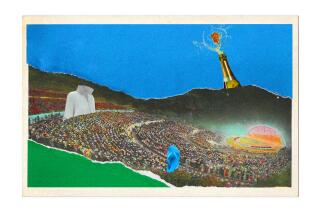Does the Hollywood sign need an electric shuttle, an aerial tram — or a second sign?

The iconic Hollywood sign has become a frustration for Hollywood Hills neighbors who complain that a crush of visitors has clogged their residential streets.
How do you solve a problem like the Hollywood sign?
The iconic sign, a perpetual lure for tourists seeking the perfect snapshot, has become a frustration for Hollywood Hills neighbors who complain that a crush of visitors has clogged their residential streets. Aggravation over the crowds has been a simmering issue in political campaigns and even spurred battles in court.
Now Los Angeles officials have turned to an outside consultant to try to quell traffic, improve safety and better manage the crowds heading to the Hollywood sign.
In a newly released report, consulting firm Dixon Resources Unlimited offers up dozens of ideas.
It imagines an electric shuttle to ferry visitors from nearby stops on the Metro Red Line and through a Beachwood Drive gate that has been blocked to hikers after a court battle, bringing them up to the Hollyridge Trail to eye the sign.
It floats the idea of an aerial tram that glides from the northern end of Griffith Park, echoing the periodic proposals for a Hollywood sign gondola, which got a fresh flurry of attention when Mayor Eric Garcetti mentioned the idea last year.
And it suggests a Hollywood sign visitor center to teach tourists about its history before they board shuttles to see the famed landmark.
The report, which was commissioned by City Councilman David Ryu, even tosses out the fanciful idea of installing a second sign proclaiming “HOLLYWOOD” from the other side of the hills, facing Burbank.
But many of the ideas are much more mundane, including installing signs to guide pedestrians, planting cypresses to obscure views of the sign that might tempt drivers to illegally stop near small vistas on Mulholland Highway, adjusting parking restrictions, and designating pick-up and drop-off spots for Uber, Lyft or taxi drivers.
Ryu, whose council district includes the Hollywood Hills, hailed the report as the first comprehensive study of how to spare neighborhoods while funneling visitors to see the beloved sign. He did not take a stand on any of the specific ideas in the report, but urged city staffers to start examining whether they are feasible.
“The Hollywood sign and Griffith Park are being loved to death,” Ryu said in a statement Wednesday. “This is a world-renowned icon, and possibly the only one without proper access to it. It’s like having the Statue of Liberty without a visitor’s center, viewing platform, or even a sign telling you how to get to it. It is unsustainable and unsafe.”
The Hollywood sign and Griffith Park are being loved to death.
— City Councilman David Ryu
The report, which cost $120,000, was shaped by meetings with residents, business owners and community groups, as well as visitor surveys and tallies of the cars, bicycles and pedestrians making their way to the Hollywood sign. Some community members got a first glimpse of the suggestions at a meeting Tuesday.
Hollywood Chamber of Commerce CEO Leron Gubler said that in the past, attempts to tackle the congestion surrounding the Hollywood sign have stalled.
“There are just so many competing interests in those neighborhoods. … You come up with one idea, someone else opposes it,” Gubler said. But this time, “one study will allow them to vet all these different alternatives. Everyone can read the report and come up with their viewpoint. … I think we have a way forward now.”
But the report will hardly squelch the debate over what, exactly, the city should do. Sarajane Schwartz, who belongs to a group of Beachwood Canyon homeowners who sued the city over the tourist traffic, argued that the report did not properly address safety concerns about narrow, gridlocked streets that could thwart ambulances or firetrucks from reaching residents.
“The whole orientation of the plan seems to be, ‘How can we transform a residential neighborhood into an amusement park?’ ” Schwartz said.
Others welcomed the report as a step forward. Missy Kelly, vice president of the Beachwood Canyon Neighborhood Assn., said some of the ideas, such as the aerial tram, seemed “pie-in-the-sky.” But she praised the report as thorough and needed, saying that it “moves us towards solutions rather than complaints.”
“For years I’ve listened to people complain, and their only solution has been, ‘Get the tourists off the street,’” Kelly said.
But she wondered aloud whether the report would just end up being shelved at City Hall.
“Probably in a year someone on the City Council will say, ‘It’s time we voted on that, because people are complaining we didn’t do anything,’” Kelly said.
Twitter: @AlpertReyes
UPDATES:
3:40 p.m.: This article was updated with comments from Beachwood Canyon homeowner Sarajane Schwartz.
This article was originally published at 12:25 p.m.
More to Read
Sign up for Essential California
The most important California stories and recommendations in your inbox every morning.
You may occasionally receive promotional content from the Los Angeles Times.











